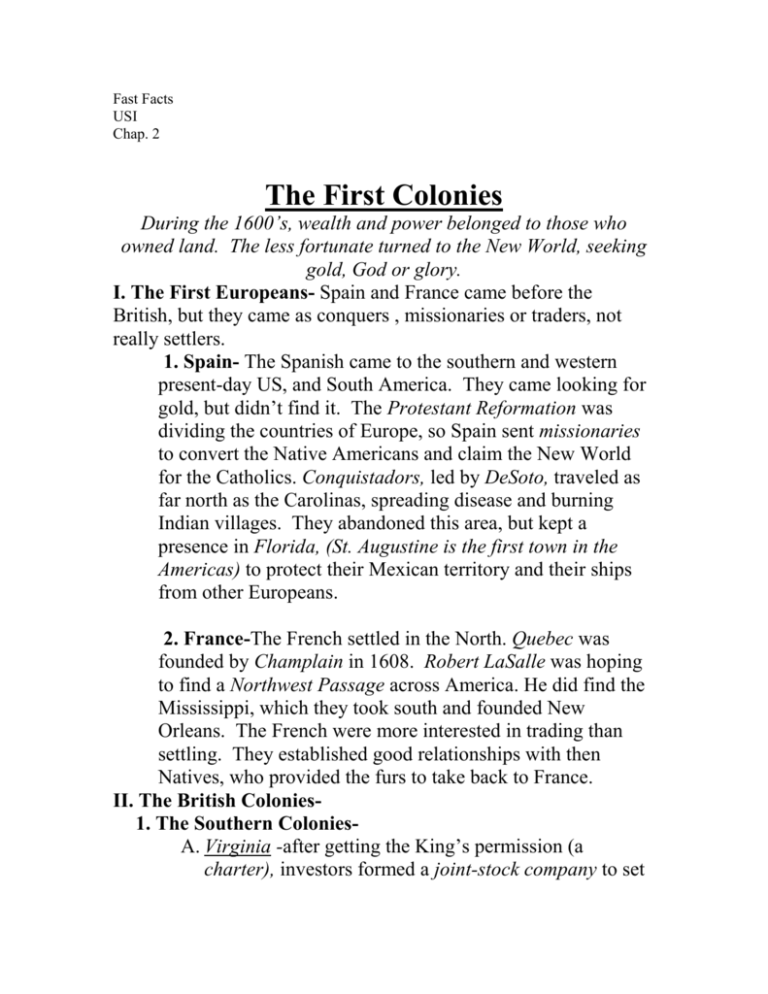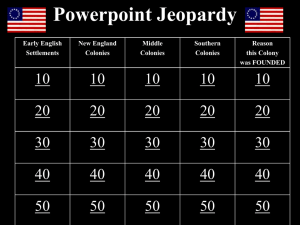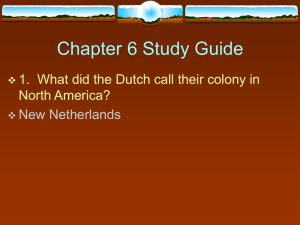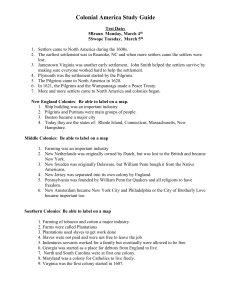The First Colonies
advertisement

Fast Facts USI Chap. 2 The First Colonies During the 1600’s, wealth and power belonged to those who owned land. The less fortunate turned to the New World, seeking gold, God or glory. I. The First Europeans- Spain and France came before the British, but they came as conquers , missionaries or traders, not really settlers. 1. Spain- The Spanish came to the southern and western present-day US, and South America. They came looking for gold, but didn’t find it. The Protestant Reformation was dividing the countries of Europe, so Spain sent missionaries to convert the Native Americans and claim the New World for the Catholics. Conquistadors, led by DeSoto, traveled as far north as the Carolinas, spreading disease and burning Indian villages. They abandoned this area, but kept a presence in Florida, (St. Augustine is the first town in the Americas) to protect their Mexican territory and their ships from other Europeans. 2. France-The French settled in the North. Quebec was founded by Champlain in 1608. Robert LaSalle was hoping to find a Northwest Passage across America. He did find the Mississippi, which they took south and founded New Orleans. The French were more interested in trading than settling. They established good relationships with then Natives, who provided the furs to take back to France. II. The British Colonies1. The Southern ColoniesA. Virginia -after getting the King’s permission (a charter), investors formed a joint-stock company to set up a colony in Virginia. The first colony was Roanoke, but the settlers of Roanoke vanished without a trace. The second colony was Jamestown, named after King James I. Captain John Smith was the leader. The colonists were ill- equipped for life in the wilderness and suffered disease and starvation. They survived due to the help of the Native American woman, Pocahontas, who persuaded her father, Chief Powhatan to befriend the colonists. The colony became successful by growing tobacco, and selling it back in England. New settlers came, lured by the promise of free land (the Headright System). They set up a representative government, called The House of Burgesses. The colony had started as a proprietary colony (owned by individuals) but became a royal colony (owned by the King) in 1624. The growth of the colony led to problems with the Native Americans. Nathaniel Bacon burned Jamestown to protest the lack of protection for the poorer settlers on the outskirts of the colony (Bacon’s Rebellion), so their leaders lowered taxes and extended protection to the frontier. B. Maryland- King Charles gave the territory to Lord Baltimore (proprietary colony). Baltimore was a Catholic, and the colony became a safe place for Catholic settlers. C. Georgia- James Oglethorpe, leader of this proprietary colony, created a safe place for debtors. England wanted this settlement to protect the northern colonies from the Spanish in Florida. D. The English also founded North Carolina and South Carolina, which were divided into separate colonies. 2. New England- Unlike the Southern Colonies, the New England colonies were settled for religious reasons (God, not gold). In spite of the cold climate and rocky soil, the colonies were successful. A. Puritans and Separatists felt that the Church of England was too similar to the Catholic Church, and they did not like the King telling them how they had to worship. They wanted to separate (Separatists) and practice “pure” religion (Puritans) in the new world. B. Pilgrims- The first New England settlers were Puritans who sailed to Plymouth, Massachusetts on the Mayflower. They wrote and signed The Mayflower Compact, which outlined a representative government. William Bradford was the leader of Plymouth Colony. The Puritans were grateful for the help provided by the Native Americans, which got them through the tough winter, but relations became unsettled in later years. The Puritans had far less interest in converting the Natives than Catholic settlers from Spain. C. Massachusetts Bay Colony -John Winthrop led a much larger group of Puritans who founded Boston. They spread throughout New England and founded Connecticut and New Hampshire. The Puritans started public schools and colleges. D. Rhode Island- Once they Puritans had religious freedom, they didn’t want to give it to anyone else! Roger Williams and Ann Hutchinson were kicked out of Massachusetts for refusing to conform to Puritan ideas. Williams founded Providence, Rhode Island and declared that they would be tolerant of other religions and separate church and state. 3. The Middle Colonies- Unlike the other colonies, the Middle colonies were founded by the Dutch and the Swedes, who were all business. These colonies attracted settlers from many different countries. A. New York- Businessmen formed The Dutch East India Company to trade fur with the Native Americans. They built New Amsterdam at the bottom of Manhattan Island. Peter Stuyvesant was placed in charge. Dutch settlers spread through present-day New York and New Jersey. They called their territory New Netherlands. England did not like this Dutch territory separating New England and the Southern Colonies, so they sailed in and took over. New Netherlands became New York State, New Amsterdam became New York City and a new colony was formed across the Hudson River (New Jersey). B. Pennsylvania- William Penn was granted a huge piece of land west of New Jersey. He called its first town Philadelphia. Penn was a member of the Quakers, a religion that believed in peace, gender equality, and religious toleration. C. Delaware- The Swedes who founded Delaware combined farming with fur trading in New Sweden. They were eventually taken over by the Dutch.





